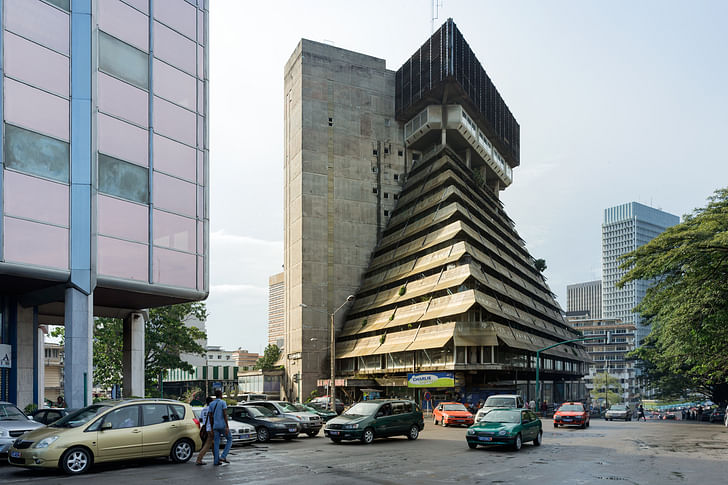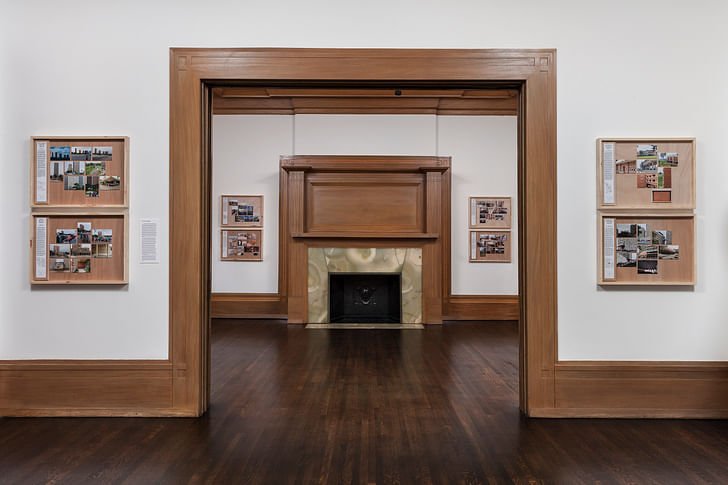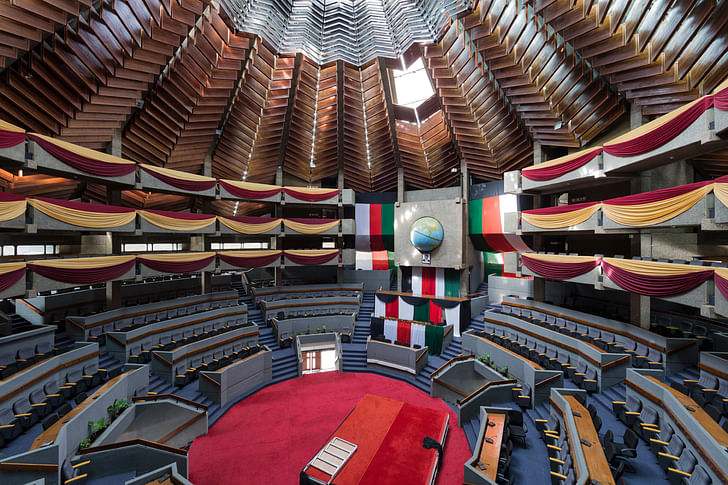

"African Modernism: The Architecture of Independence" is a sprawling and immersive exhibition that uses every inch of available gallery space at Chicago’s Graham Foundation. Curated by Manuel Herz with input for this particular exhibition by Sarah Herda, head of Graham Foundation, the show is based on Herz’s voluminous tome of the same name. At over 700 pages, Herz’s scholarly investigation and cataloging of modern architecture in Ghana, Senegal, Cote d’Ivoire, Kenya, and Zambia provided a surplus of projects and information, requiring a careful distillation to produce the exhibition.
As a viewer experiences the show, it becomes clear that the curatorial process consciously eschewed the ever-present desire to categorize buildings and architects into a projective taxonomy. Where most exhibitions push and pull the material in order to weave a common thread, "African Modernism" presents the complex whole with a minimum of commentary, leaving the viewer to plumb the context, the associated talks, and dig deeper into the history and architecture of these countries in order to understand the buildings on display.

First mounted at the Vitra Design Museum in Weil em Rhein, Germany, the exhibition features photography by the indefatigable Iwan Baan and South African Alexia Webster. Simple, well-detailed natural wood and glass cases frame the materials on display, featuring uncomplicated spreads of Baan and Weber’s photography and Herz’s writing describing the origin and evolution of the featured projects. A second component to the show is a horizontal display case of archival drawings, photographs, and letters giving insight into the original a vast coterie of strategies for addressing the social, political, and climatic specificities of these diverse countries.design and social and political genesis of five exemplary projects (one from each country) featured in the show. While the majority of the material in the exhibit is divided into separate rooms by country, this last element brings these archival materials together with photo essays by Baan and Weber in a dedicated room, providing a singular point of unification to a show (and an architecture) with a vast coterie of strategies for addressing the social, political, and climatic specificities of these diverse countries.
The exhibition (and the book it is based on) provides invaluable context for comparing projects and architectures by giving insight and background to the politics and geography present at their inception. The 80 buildings covered in the show were mostly constructed in the 1960s and 1970s, the vast majority being variations on the International Style and completed by European firms. The curatorial treatment allows the subtle similarities and differences in the work to become apparent as the viewer takes in the exhibit.


Were this a simpler exhibition, message immediately apparent in black and white, perhaps the takeaway would be easier. Instead, it is a show that grows on you. At first modest and requiring time and introspection of the viewer, it reveals a dizzying array of textures and forms with time, illustrating the subtle connections that climate, politics, and power has wrought on Nor is Africa bereft of the white elephant of postmodernism, providing utterly unusable space to complement unsavory form.architectural form. The familiar massing and materials of the International Style exported by architects working in the European modernist tradition take on a new, humane life when hybridized with the unique program and vernacular typologies of Africa. The open plan finds full expression in tropical climates, with cantilevered overhangs, blurred transitions from interior and exterior, and screens and scrims mediating light. Much of the work is by British and French architects (the colonial powers in the five countries studied), but Israeli, Scandinavian, and Yugoslav architects were all building in these young republics. Nor is Africa bereft of the white elephant of postmodernism, providing utterly unusable space to complement unsavory form. In any case, this is the first time these unique and arresting buildings have been thoroughly documented such that they may be added to the architectural cannon.

While a careful viewing of the show does reveal these commonalities in the work, it is not dominated by them. Visitors are allowed to also witness the impact of differing approaches to government and economy that these countries pursued. While pure expressions of International Style dominate in some, a more vernacular approach to modernism appears in others, making apparent the effects of political policy on form, a matter the architectural profession is all too happy to avoid. Clues as to economical and societal values abound as well, with materials, form, color, and organization all revealing subtle clues as to the states which gave rise to these buildings.

Where most shows would be handicapped by a failure to draw neat conclusions or identify a common thread, African Modernism is all the better for it, reveling in the same disorder and confusion that was present when these young countries became independent. This discordant reveling in the same disorder and confusion that was present when these young countries became independent.whole is the perfect metaphor and description for not only the exhibition and book, but also the architecture and the social and political upheaval which birthed it. In some of the countries featured, independence was granted peacefully after a lengthy inculcation with Western values and democratic ideals. In others, independence was wrested from colonisers who subsequently rejected Western styles of government in favor of tribalism and authoritarianism – remnants of which still haunt the continent to this day, and are clearly visible in the varying architectures. In all cases, the buildings serve a dual purpose – providing a lense through which to examine the motivations, aspirations, and outcomes of these young countries while superficially embodying the aesthetic and formal concerns which dominated African architecture in the 1950s and 60s.


It can be difficult to resist tokenism and false categorization when curating a show such as this. Not only is the architecture varied and diverse, but the subject and content are rife with political and social traps for the careless curator to fall into. Herz’s book is a straightforward investigation and cataloging of the immense amount and quality of buildings that have, in messy, filled with contradiction, convolution, and conflict, yet wholly inspiringmany cases, never been rigorously documented. Through his painstaking research and Baan and Weber’s exceptional photography, these buildings are recorded for history so that this important period and place may become part of the architectural canon. Transforming this research into an exhibition required a deft touch, a treatment that would distill the essence of the research and experience of visiting these places while appearing wholly invisible in terms of curatorial opinions. The exhibition succeeds in its charge, allowing the viewer to understand the architecture and the zeitgeist that gave rise to it as they really were – messy, filled with contradiction, convolution, and conflict, yet wholly inspiring, transformative and exemplary of humanity's best ambitions.

"African Modernism: The Architecture of Independence" is on display at the Graham Foundation in Chicago until April 16, 2016. More information available here.
Nicholas Cecchi is an architect born in Denver and educated in New Orleans. Following completion of his degree, he worked briefly in single-family residential architecture before leading the design department of a Denver-based boutique architectural and sculptural design and fabrication studio for ...
1 Comment
Don't you mean canon not cannon?
Also, "Nor is Africa bereft of the white elephant of postmodernism, providing utterly unusable space to complement unsavory form." seems an overly broad shot at postmodernism...
Is there a specific building that inspired that comment?
Block this user
Are you sure you want to block this user and hide all related comments throughout the site?
Archinect
This is your first comment on Archinect. Your comment will be visible once approved.